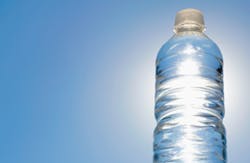Contaminant of the month: Disinfection byproducts (DBPs)
What are DBPs?
- The most commonly used drinking water disinfectants used in the U.S. are chlorine, chloramine, chlorine dioxide, ozone and UV light. The first four are oxidizing agents, and UV is effective by damaging the DNA of the microbes.
- Disinfection byproducts (DBPs) are chemical products generated by disinfectants reacting with organic or inorganic chemicals in the water. The organic precursors are predominantly natural products found mostly in surface waters and measured as "total organic carbon" (TOC) or "dissolved organic carbon" (DOC).
- Most disinfectants also leave residues and breakdown products resulting from chemical reactions with the chemicals in the water or the water itself.
- There can be hundreds of individual DBPs in disinfected drinking water. Usually they would be present in parts per billion and parts per trillion levels.
- The amounts and types of DBPs will vary with the specific disinfectant, water source, water chemistry, treatment process, precursor chemicals and time.
How are DBPs produced in water?
- Chlorine is both an oxidizing and chlorinating agent, so its byproducts include oxidized and halogenated chemicals.
- The most commonly known chlorinated organic DBPs include chemical families: Trihalomethanes (THMs, e.g., chloroform, bromoform, bromodichloromethane, chlorodibromomethane); haloacetic acids (HAAs, e.g., dichloroacetic acid, bromochloroacetic acid); halonitriles (e.g., chloroacetonitrile); aldehydes (e.g., formaldehyde); and numerous other families.
- Chlorine oxidizes bromide or iodide in the water to reactive forms that will also produce DBPs like bromoform or iododichloromethane.
- Chlorine is often applied in the hypochlorite (bleach) form. If stored for an excessive time at warm temperatures it will spontaneously produce chlorate and perchlorate.
- Chloramines are reaction products of chlorine and ammonia. They produce fewer DBPs than chlorine, but some of these include nitrosamines and cyanogen chloride.
- Chlorine dioxide is almost exclusively an oxidizing chemical so its organic DBPs are mostly alcohols, aldehydes and acids where oxygen has been added to the original precursor chemicals.
- Chlorine dioxide reacts in water to produce chlorate and chlorite.
- Ozone consists of three linked oxygen atoms so it is unstable and also reacts with natural organics to produce alcohols, aldehydes and acids.
- Ozone also oxidizes bromide in water to bromate.
- Ultraviolet (UV) lamps are mercury vapor based. The most common are low pressure germicidal lamps and medium pressure broad spectrum lamps.
- UV light can react with some chemicals in water that absorb light in specific wavelengths being emitted by the lamps. Their presence is limited so just a few DBPs are associated with UV light.
- UV light can decompose nitrosamines in the water if the appropriate wavelengths and intensities are available.
How are DBPs measured?
- Numerous analytical methods are available to measure DBPs at ppb and lower concentrations.
- Volatile lower molecular weight halogenated DBPs are measurable by gas chromatograpy and mass spectrometry techniques that use purge and trap methods to separate chemicals from the water for analysis.
- Higher molecular weight chemicals are measured by solid phase or liquid extraction and gas chromatography and mass spectrometry or by high performance liquid chromatography (HPLC) and mass spectrometry.
- Ionic inorganic DBPs like bromate and chlorate are measured by ion chromatography.
What concentrations of DBPs are produced?
- DBPs are the most ubiquitous synthetic chemicals found in drinking water.
- THMs and HAAs are commonly present at mid ppb levels (~ 10 to 80 ppb).
- Most other organic DBPs are produced at low ppb or ppt levels.
- Chlorate and chlorite are produced at fractional milligram levels.
- Bromate is produced at ~1-25 ppb; perchlorate at low ppb levels.
Potential health effects
- Some DBPs are animal carcinogens based upon high dose testing; some are mutagenic based upon in vitro testing.
- About 65 epidemiology studies of varying quality have been published in the last 40 years since THMs were detected in the early 1970s. Perhaps 12 are considered to be good quality studies.
- Results are not always consistent between studies. The most consistent results have indicated a possible small increased risk of bladder cancers for chlorinated drinking water.
Water treatment:
- The World Health Organization advises that microbial waterborne disease is the most significant risk from drinking water, and controlling DBPs should never increase the risk of waterborne disease.
- Volatile DBPs can be removed by aeration. Most DBPs can be removed by granular activated carbon.
- The most desirable DBP treatments are preventive, e.g., reducing the TOC levels by pretreatments before adding the disinfectant.
- Chloramines used as secondary disinfectants reduce the amount of delayed DBP formation that occurs during water distribution.
Regulation
- The principal organic DBP regulations are total trihalomethanes (80 ppb), and haloacetic acids (60 ppb). To a great degree those two groups of chemicals are used as indicators of the presence of other unmeasured DBPs, so processes that reduce them also reduce many other DBPs.
- Regulations for inorganics include: Chlorine (4 mg/l); chloramine (4 mg/l); chlorine dioxide (0.8 mg/l); chlorite (1 mg/l); and bromate (0.010 mg/l).
- Perchlorate and chlorate are being considered for federal regulations. Some states have regulations or guidelines/advisories.
Dr. Joe Cotruvo is president of Joseph Cotruvo and Associates, LLC, Water, Environment and Public Health Consultants and technical editor of Water Technology. He is a former director of the EPA Drinking Water Standards Division.
